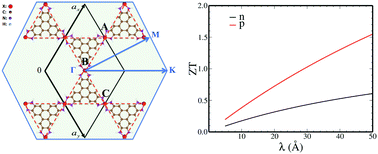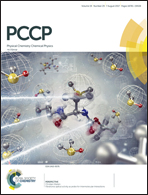Two-dimensional metal–organic frameworks with high thermoelectric efficiency through metal ion selection†
Abstract
Two-dimensional (2D) materials have attracted much attention due to their novel properties. An exciting new class of 2D materials based on metal–organic frameworks (MOFs) has recently emerged, displaying high electrical conductivity, a rarity among organic nanoporous materials. The emergence of these materials raises intriguing questions about their fundamental electronic, optical, and thermal properties, but few studies exist in this regard. Here we present an atomistic study of the thermoelectric properties of crystalline 2D MOFs X3(HITP)2 with X = Ni, Pd or Pt, and HITP = 2,3,6,7,10,11-hexaiminotriphenylene, using both ab initio transport models and classical molecular dynamics simulations. We find that these materials have a high Seebeck coefficient and low thermal conductivity, making them promising for thermoelectric applications. Furthermore, we explore the dependence of thermoelectric transport properties on the atomic structure by comparing the calculated band structure, band alignment, and electronic density of states of the three 2D MOFs, and find that the thermoelectric transport properties strongly depend on both the interaction between the ligands and the metal ions, and the d orbital splitting of the metal ions induced by the ligands. This demonstrates that selection of the metal ion is a powerful approach to control and enhance the thermoelectric properties. Interestingly we reveal an unexpected effect where, unlike for electrons, the thermal and electrical current may not be equally carried by the holes, leading to a significant deviation from the Wiedemann–Franz law. The results of this work provide fundamental guidance to optimize the existing 2D MOFs, and to design and discover new families of MOF-like materials for thermoelectric applications.



 Please wait while we load your content...
Please wait while we load your content...